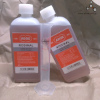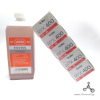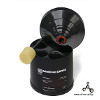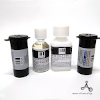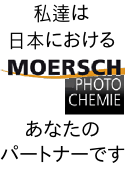In this test I want to compare the three main films from Foma.
Fomapan 100, 200 and 400. All films are from the "profi line", which give most consistent and best results in my experience.
The films will be tested at real speed, not at box speed. The real speed of Fomapan 100 is ISO 100/21°, of Fomapan 200 it is also ISO 100/21° and of Fomapan 400 it is ISO 200/24°.
Fomapan 100 and 400 are cubic grain films. Fomapan 200 is a film with tabular grain. Foma calls it "hexagonal core/shell tabular" grain. Therefore the fixing time for Fomapan 200 is longer. I measured a 2.3 times longer clearing time compared to Fomapan 100.
Fomapan 100 has a bit more purple color compared to Fomapan 200 and 400, which are more green.
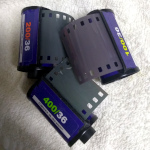
As a developer I will choose SPUR Silversalt. I choose it, because it gets the real speed out of the films and is very sharp. It does not change the density graph of the films in the sense that it preserves the "natural" graph and character of the film. Also the grain is preserved. Adox Atomal 49 for example is a compensating developer and makes the highlights flat and rounds the grain. Adox Rodinal is the opposite. It tends to make the highlights steeper at standard dilutions. I want to preserve the true character of the film, hence SPUR Silversalt.
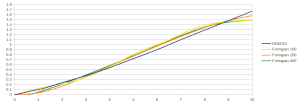
First I made a film resolution test. The contrast of the target was 1:64 (6 stops). That is the contrast which often can be found at a street scene. The resolution is higher at a contrast of 1:1000, but 1:64 is more realistic in the photographer's every day life.
The results are:
Fomapan 100: 37 lp/mm
Fomapan 200: 37 lp/mm
Fomapan 400: 33 lp/mm
Please note that those results can not be compared directly with any other results from resolution tests. They are too depended on the individual test setup.
After this I made a color test. How each colour is represented in monochrome. Fomapan 100 has a noticable darker red compared to 200 and 400. Fomapan 400 has the brightest red and the darkest green.
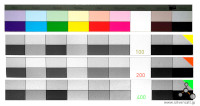
The test photos were shot with the data obtained from density graphs. Zone 1 for film speed and zone 8 for developing time are the reference points. This is the data I recommend, but of course the look of the films can be changed strongly by changing exposure, developing time or using another developer. There was no effort from my side to tone match the films; for example by giving Zone 5 the same density throughout all three films.
The scene for Fomapan 400 is a bit different, because I made an error when setting the ISO and had to re-create the scene after I already broke it down.
Scans are of course no substitute for real prints. The grain looks rougher on the scan than on a print for example. But they might give you a first impression of the film's look.
On the negative the grey scale field on the test photo, which is clearly distinguishable from the next darker field is
Fomapan 100: field 17 (from 18)
Fomapan 200: field 18 (whole grey scale)
Fomapan 400: field 18 (whole grey scale)
This shows us that exposure was sufficient (good shadow detail on the negative), even if the fields are too dark on the scan.
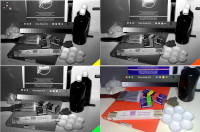
I think Fomapan 400 has a gritty look. The dark green and light red produce a strong contrast on color base. The grain is quite prominent. Especially when shot at the box speed of ISO 400/27°, the film looks very raw with low shadow detail. Exposed at the real speed of ISO 200/24° the shadow details are better, but the grain tends to be bigger than at ISO 400/27°. It is a film for very strong expression.
Fomapan 200 has the most modern and conventional look of the three films compared here. Surely it is a result of the tabular grain structure. Exposed at the real speed of around ISO 100/21°, this is the best medium-speed allround film of all Fomapans.
Fomapan 100 has a very classic feeling. Maybe it is because of the dark reds which remind me of the old orthochromatic films. It is quite a unique emulsion with a special look. You have to be careful with the highlights. They easily blow out. IT is a nice film for portraits or if you want to have a vintage look in your photos.
Other recommended developers:
Adox Rodinal is very good for Fomapan 100 and 200. If you like grain it is also well suited for Fomapan 400. With Fomapan 100 you have to be a bit careful to avoid that the highlights get too dense.
SPUR Acurol N is very good for Fomapan 100 and 200. Exceptionally sharp.
If you want fine, but not too rounded grain, SPUR HRX is a good choice for Fomapan 100, 200 and 400.
If you want to expose Fomapan 400 at ISO 400/27 and don't want grain, try Adox Atomal 49. Of course the film will not reach real ISO 400/27, but the grain will be less visible compared to the developers mentioned above.
Fomapans have a tendency to produce uneven results if not agitated enough. Depending on developer and dilution it is possible that even a agitation break of just one minute is too long and uneven development starts from the perforation holes and short sides of negative.






